Ural-batyr
Ural-batyr or Ural-batır (Bashkir: Урал батыр, pronounced [uˈrɑɫ.bɑˌtɯ̞r], from Ural + Turkic batır - "hero, brave man") is the most famous kubair (epic poem) of the Bashkirs. It is telling of heroic deeds and legendary creatures, the formation of natural phenomena, and so on.[1][2]
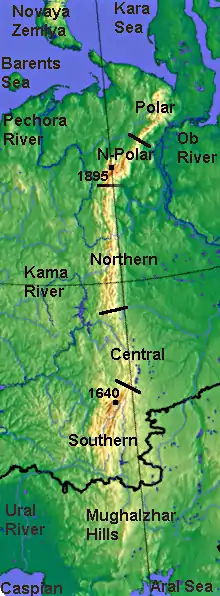
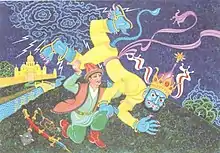
It is analog many similar epics (the Anglo-Saxon Beowulf, the Germanic Nibelungenlied, the Mesopotamian Gilgamesh, or the Finnish/Karelian Kalevala). The epic poem propagates the idea of the nation's eternal life and the ability of man to vanquish evil.
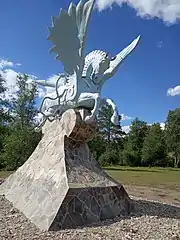
Plot
Based on the Turkic and Iranic folk song traditions, the poem narrates about the heroic deeds of Ural-batyr. Ural is born to an elderly couple, Yanbike and Yanbirðe.[3] Yan (from Persian word جان jan, meaning "soul"), and Yanbirðe means "Given Soul", while Yanbike means "Woman of Soul" . Ural evinces from his very infancy all the features of a legendary hero, such as unflinching courage, honesty, kindheartedness, empathy, and great physical strength. Unlike his cunning and treacherous brother Shulgan (see Sulgan-tash), Ural is an eager enemy of the evil and of Death which personifies it. Having matured, Ural sets out on the quest for Death, with the desire to find and destroy Him. On his way, he meets with various people and legendary creatures and is often deferred by long adventures; in all cases, his actions serve to save lives or quell the evil. Riding his winged stallion Akbuthat (or Akbuz At; White-Grey Horse),[4] he saves young men and women prepared for sacrifice by the tyrannical Shah Katil from imminent death, tames a wild bull, destroys an immense number of devs, marries the legendary Humai (from Persian همای Humay), a swan-maid, and finally smites the chief dev (from Persian دیو div) Azraka, whose dead body is said to have formed Mount Yaman-tau in the South Urals. Ural-batyr perishes in his final grapple with the devs, as he is forced to drink up a whole lake where they had hidden from him, but he leaves his sons to continue his initiative.
History
The poem, originally existing solely in the oral form of a song, was set in the written form by the Bashkir folk poet Mukhamedsha Burangulov in 1910. This story is very ancient, and reminds of some of stories from Babylon and Sumer. The epos reproduces some pre-Biblical story about Kain and Abel. There are traces of Iranian civilization in Bashkort and Tatar cultures, as some words and names of cities and people.
The epic was transmitted orally from generation to generation by storytellers - sesens. In 1910, Mukhamedsha Burangulov recorded an epic from two kuraist musician) and sesens (poet), Gabit Argynbaev (≈ 1850 - 1921) from the аul(village) of Idris and Khamit Almukhametov (1861 - 1923) from village of Malyi Itkul (volost Itkulskaya of the Orenburg province).Researchers believe that M. Burangulov came to sesens more than once, wrote down the epic in parts. Researchers found that both storyteller came from the Burzyan clan. Both sesen well knew the area around the Shulgantash cave (Kapova cave) and Lakes Shulgankul, Yylkysykkankul (they are described in the epic). Gabit-sesen’s grandfather Argynbay moved from the highlands of Burzyan to the steppe region. Both sesen were in kinship.
There are known other versions of the epic. A fairy tale of the same name in prose was recorded in 1956 by Ismagil Rakhmatullin in the village of Imangul in the Uchalinsky district of Bashkorostan by researcher Akhnaf Kharisov (published by him in the same year). The version, conventionally referred to as an `` etiological myth , was recorded in 1984 from Shamsia Safargalina in the village of Gabbas, Zianchurinsky district of Bashkortostan.
In 1968, the epic "Ural-Batyr" was published in the Bashkir language in the journal "Agidel" in 1968 with abbreviations (prepared by B. Bikbai and A. Kharisov). In 1972, the first full publication in the Bashkir language took place — in the first volume of the book series “Bashkir Folk Oeuvre”.
In 1975, it was published in the first volume of the collection “Heroic Epic of the Peoples of the USSR” in the series “Library of World Literature” (translation by A. Kh. Khakimov, I. S. Kychakov, A. S. Mirbadalev), and also in the series “ The Epos of the Peoples of the USSR ”(per. A. Kh. Khakimov, N. V. Kidysh-Pokrovskaya, A. S. Mirbadalev) in abbreviated form.
For the first time, the profound originality of the epic “Ural-Batyr” was announced in the works of A. A. Petrosyan. She was the first of the researchers to discover a plot similarity between the Bashkir epic and the Sumerian-Akkadian epic about Gilgamesh. But she came to the conclusion that there are deep differences in the ideological and artistic concepts of these works: “The main motive of the epic“ Ural-Batyr ”is that man is stronger than all that is , good is indestructible. The Babylonian epic rests on another idea - everything from the will of the gods.
The philosopher Damir Valeyev considered the epos “a source for studying the history of social consciousness and social thought of the Bashkirs”.
There are several translations of the epic into Russian - both interlinear and poetic. Translations into Russian were made by several writers and poets. The prose arrangement of the epic was performed by the writer Aidar Khusainov, the poetic translation into Russian was done by the poet Gazim Shafikov.
In 2003, a gift edition of the epos was published in Ufa in three languages (Bashkir original, Russian translation by G. G. Shafikov and English translation by S. G. Shafikov). In 2006, Ural-Batyr was published in German, translated by the doctor of philology Aliya Taysina (Germany) (Ural-Batir: Das baschkirische Volksepos in der Übersetzung von Alia Taissina mit Illustrationen von Rais Khalilov. Taschenbuch: 108 Seiten, Auflage: 1, Sprache: Deutsch, ISBN 3-939165-02-6, ISBN 978-3-939165-02-6).

The epos "Ural-Batyr" has also been translated into other languages of the world (Abkhazian, Hebrew, Turkish, Chuvash , French and others).
In 2007, the original text of the Ural-Batyr was first published (Шакурова Ш. Р. « Башкирский народный эпос «Урал-Батыр». Архивный первоисточник и его текстологический анализ. Уфа: Гилем, 2007).
In 2013, the Ural-Batyr was published in three books, in Bashkir and Russian (translation by A. Kh. Khakimov), in Bashkir and French (translation by R. K. Garipov), in English and Bashkir (translation by Z. A. Rakhimova) languages.
All previous publications of the epic contained distortions. The reasons for the uncritical publication of the epic lie in the Soviet practice of distorting monuments of folk art, in the persecution of Bashkir scholars (Mukhametsha Burangulov was twice arrested and was in prison). The manuscript of the epic is lost.
The decisions of the Central Committee of the Communist Party on the Bashkir party organization banned a number of folklore monuments. However, despite the repression, the epic “Ural-Batyr” miraculously survived. After his release, M. Burangulov fought for the right to be creative and defended the works of Bashkir folklore.
The original in a typewritten copy in Latin script (verses with prosaic inserts) with several handwritten corrections (probably by M. Burangulov himself) is stored in the Scientific Archive of the Ufa Scientific Center of the Russian Academy of Sciences.
Scientists continue to study the epic "Ural-Batyr" in-depth at the intersection of archeology, ethnography, linguistic folkloristics. Along with folklorists, the Bashkir archaeologists, linguists, philosophers, and ethnographers also studied the epic Ural-Batyr (G.B. Khusainov, D.Zh. Valeev, Z.Ya. Rakhmatullina, A. Kh. Davletkulov, Z.G. Aminev , F. B. Sanyarov, G. Kh. Bukharova, V. G. Kotov).
In 2011, the bibliographic index “Bashkir National Cubair (Epic)“ Ural-Batyr ”” was released, which presents a list of materials reflecting the results of a comprehensive study of the epic (publications from the publication of its text in a journal version in 1968 to our time).
In Bashkortostan, much is being done to popularize the epic. The performance “Ural-Batyr” was staged at the Bashkir Academic Drama Theater named after M. Gafuri, the popular science film “In Search of Akbuzat” was created, the tourist project “The Golden Ring of Bashkortostan: the roads of the epic“ Ural-Batyr ”was developed. Every year, a contest is held for the best reciters of the epic in Bashkir and other languages. Performances based on the epic are included in the repertoire of the Bashkir State Puppet Theater (in Bashkir and Russian). In 2010, by order of the Ministry of Culture of the Russian Federation, the director and screenwriter A. Lukichev shot the animated film Ural-Batyr based on the Bashkir epic (14.01 min., Moscow).
The epic "Ural-Batyr" is one of the "Seven Wonders of Bashkortostan".[5] The epic is included in the TURKSOY List of Intangible Cultural Heritage.[6]
.jpg.webp)
URAL-BATYR (content)
The theme of the legend, despite a significant element of fairy-tale fantasy, is heroic-epic.
Introductory part
Ural-Batyr is clearly divided into several parts. In the introductory part of the work, the most ancient strata are preserved: echoes of the legends of the global flood, the revival of life on earth after the flood, the first couple of people that laid the foundation for the human race. Old men Yanbeerde and Yanbeeke with their sons (Shulgan and Ural) settle on a small patch of land surrounded on all sides by the sea. Assistants to Yanbeerde and Yanbeeke are animals: gyrfalkon , lion, pike. Ural sometimes turns to birds and animals for advice.
Ural and Schulgen personify two opposing principles - good and evil - which lead an irreconcilable struggle between themselves. Before going hunting, parents drink the blood of animals, which gives them strength. Parents forbid them to do this until they become Yegets (adult fellow).
Ural learns about Death
- How Schulgen violated his father's ban
Schulgen went against the ban of his father and drank the blood of animals.
- How Yanbeeke and Yanbeerde returned home
Parents return from hunting. Ural finds out that there is Death. But in these places Death did not appear. There is no power that can kill a person.
- How Yanbeerde discovered that someone drank from shells and what came of it
Yanbeerde was terribly angry with his sons when he learned that one of them had tasted blood.
- What animals and birds said when they gathered at the call of Yanbeerdе
Ural delivers a speech in front of animals and birds. He offers to stop offending the weak, stop eating each other's meat. Then Death will remain alone and it can be destroyed.
The crow is not afraid of Death. It offers the weak themselves to hide in a safe place.
Ural learns about the Living Spring
- How the white swan was caught
Yanbeerde and Yanbeeke began hunting with their sons together. Among the prey is a white swan. This is the daughter of the Sun, Homay, her father is the heavenly king of birds Samrau (Semurg).
The swan promises to show the path to the Living Spring (Yenshishma).
Ural stood up for the bird.
But the old man and his sons did not manage to know the way to the Living Spring (water). Yanbeerde gives his sons powerful lions and sends them to look for the way to the Living Spring (water). If they meet Death on the way, they must cut off its head and bring her home. (There are many mineral springs, water, in the Urals)
Part 1
- Ural and Schulgen meet the old man and cast lots
Years passed. The brothers have matured. Once he met on his way an old man with a long staff. The brothers asked the old man to show them the way to the Living Spring. He indicated two roads: to the right is the land of King Samrau (the land of eternal happiness and good), and to the right is the land of King Katil (the land of eternal grief and evil). Shulgan decided to go to the kingdom of Samrau (although he fell to another lot ). Ural had to go to the kingdom of Katil.
- How Ural Batyr came to the country of padishah Katil
In the kingdom of Katil, Ural meets unfortunate people who tell him about the atrocities of the cruel king (the old woman, her daughter, the old man). Then he himself sees Katil donate people to the lake and to the fire (Perhaps these were the memories of the Bashkirs about the brutality of foreign invaders).
- How Ural Batyr met Padishah Katil`s daughter
Ural meets a huge crowd of naked people, guards beat them with whips. Katil`s daughter chooses Ural as her husband, gives him a Golden Apple. Ural refuses to become her husband. Slaves carry King Catilus, seated on a throne. He is very fat, like a fat boar. His eyes are bloodshot.
In the legend there is no scene of the struggle of Ural with the padishah Katil. Ural fights one on one with its huge bull, and then - with the four strongest heroes of the padishah. In a duel with a bull, Ural bend horns, and they remain forever bent; the hero knocks out the upper tooth to the bull, and he will never grow back; he tears the hooves of the animal, and they never grow together (an etiological motive). The hero says that now the bull and his tribe will become slaves of man.
Katil and his guard scatter in an unknown direction. The people are asking Ural to marry the daughter of Katil and become their padishah.

Part 2
- How Ural-Batyr met Zarkum
Ural- Batyr meets Zarkum, the son of the King of serpents Kahkaha, who wants to marry the daughter of King Samrau. Zarkum gives Ural the secret of his father.At the request of Zarkum, he broke off the deer horns and Zarkum swallowed the deer. Zarkum turned into a handsome young man. He wants to marry Homay.
- How Ural-Batyr and Zarkum arrived in the serpent kingdom
In the palace of Kahkaha, a snake with nine heads wants to swallow Ural. But Ural hit it the main head with a sword and the keys fell out. Ural hit other heads and eight heroes came out from there, swallowed by a snake. The key to the palace of secrets fell from the heart of the serpent.
- How Ural-Batyr entered the palace of secrets
Ural opened the palace with a magic key, saw a girl on the throne, took the magic staff of Kahkaha. Kahkaha calls all the snakes for help. But Ural Batyr defeated them. Kahkaha pretended to admit defeat. Ural allows people to elect themselves the new ruler (Algur). The old hero Algur asks Ural to marry a beautiful girl (Gulistan) from the palace and leave his offspring to the people («Tul alu», getting the hero’s genetic material to strengthen the folk is an ancient tradition).
Part 3
- Schulgen meets a handsome young man
Shulgen (Ural`s brother) met a handsome forever young man picking flowers and was glad that he would soon be in the country of eternal happiness and youth.
- How did Schulgen get to a happy country
Schulgen got to happy countrie, wanted to catch fish, but saw that no one was attacking each other here, everyone was living peacefully. Schulgen decided to go to the Living Spring and arrange a lunch here on his way back.
_-_panoramio.jpg.webp)
Schulgen opened his heart to evil
- How Schulgen met Zarkum
Schulgen met the handsome young man again. But it was Zarkum who from Ural. He tricked Shulgen into going into the kingdom of Azraka, the king of divas, fantastic giants.
- How Shulgen and Zarkum arrived in the kingdom of Padishah Azraka
Zarkum agrees with Azraka secretly from Shulgen on how to kill Ural. To do this, you need to seize the winged horse Akbuzat. The divas who tried to bring Akbuzat to Azraka`s palace were thrown by the horse high into the sky. So there was Constellation Yetegan (the Constellation of the Big dipper). If the daughter of the king of birds Samrau falls in love with Shulgen, then she will give him Akbuzat and a magic sword. The divas need them to destroy Ural, the worst enemy of the divas.
- How Shulgen entered the palace of the padishah of divas Azraka
Azraka warmly welcomes Schulgen, treats him in his palace, gives rich gifts. Shulgen is offered to marry the "daughter" of Azraka. But it’s actually Ayhılu , the daughter of Samrau (the king of birds), captive of Azraka.
- As Azraka spoke with Shulgen and Zarkum
Azraka tells Shulgen and Zarkum about the magic horse Akbuzat, a damask sword that is not given to everyone and the most beautiful girl in the world - Homay. Zarkum and Schulgen decide to go in search of them in order to become stronger than everyone else.
- How Shulgen and Zarkum met Homay
Divas brought Shulgen and Zarkum to the kingdom of Samrau. They ended up in a flock of birds (girls). One of them is Homay. She throw Shulgen and Zarkum into different pits. Homay recognizes Shulgen and scoldes him for choosing a snake as his friend. To become free, Schulgen must learn to choose his friends, open his heart to love.
Ural fell in love with Homay
- How Homay met Ural- Batyr
Homay joyfully meets Ural.Ural- Batyr did not recognize her. He asks to show him the way to the Living Spring. Homay asks to find an unusual bird, promises to give him the horse Akbuzat and a magic sword.
- How Ural Batyr found an unprecedented bird
Ural goes in search of the unusual bird and finds an amazing bird. She turns into a fish, then a bird, then a girl. This is Aihylu. She tells her story, promises hero her horse Harisay (Yellow) . Ural brings Aihilu to the palace of her father, King Samrau. Samrau sends Aihylu to her mother Ai (Moon, Selene) so that the divas do not find her.
- How the Ural-Batyr learned that his love is Homay
Ural- Batyr recognized the swan saved by him in the mistress of the palace. He asks Homay to fulfill his promise. Homay goes to his father. Padishah Samrau allows his daughter to give Ural the horse Akbuzat and damask sword. He wants to marry Ural to his daughter Homay. She must give birth to a hero like the Urals. Samrau asks to release Shulgen on the occasion of the wedding of Ural and Homay.
- How Ural-Batyr and Shulgen met
Ural is happy seeing his brother. Homay does not tell him that Shulgen came to the kingdom of Samrau with Zarkum, that he is friends with the divas. Shulgen intendes to take away the winged horse, the magic sword and the Padishah`s daughter Homay from Ural . At a festival hosted by Homay, men must show their strength.The Padishah's daughter will choose a winner as her husband .
- How Ural-Batyr and Shulgen competed on the Maidan
At the call of Homay, Akbuzat (the winged horse) descends from the sky. A damask sword is attached to his saddle. How beautiful was this unusual horse! Heroes must raise a huge stone. Shulgan was unable to raise the stone. Ural Batyr easily lifted the stone and threw it high into the sky. The stone was lost sight of until evening. The Ural caught this stone just as easily and threw it strongly towards the kingdom of Azraka.
- How Schulgen regained his wife
Shulgan hates deeply his brother. Ural sees the misfortune of his elder brother, but does not know what was going on in his soul. Homay and Ural ask the padishah to give Aihylu Shulgen to his wife. Aihylu falls from the sky to the ground like a ball of fire. The wedding continues.
Homay and Aihylu are endowed with the properties of peri- traditional female images in Turkic mythology.
_(1).JPG.webp)
Ural entrusted his magic staff to Shulgen
- How the Ural-Batyr gave his staff to Shulgen and what came of it
Shulgen asks Ural to give him the magic staff, then striking with the staff on the ground, disappears. Water pours from the bowls and floods everything around. Zarkum turns into a huge fish and swallowed Homay. The sun (mother of Homay) ceases to shine without Homay. Akbuzat blocks the way to a turbulent stream, Zarkum releases Homay from his mouth. Ural- Batyr learns that his brother has become an enemy. The sun is shining again, because Homay is saved.
- Zarkum and Shulgen again at the padishah of divas
Shulgen and Zarkum returned to the kingdom of Azraka. Azraka recognized his staff in Shulgen’s hand and decided to return it in any way. Azraka, Zarkum, Kahkaha, Shulgen decided to start a war against Ural and Samrau.
- How the war with the divas began
From all sides divas attacked the earth. There was water all around, the sky was all on fire. Ural said goodbye to Homay, jumped on Akbuzat, picked up his magic sword and went to war with the padishah of divas, to save the life on earth.
- How did the padishah Azraka find his end
Ural- Batyr fought for a long time with the padishah of divas Azraka. The faithful horse Akbuzat has repeatedly saved the hero during the battle. Ural- Batyr hit with a damask sword and cut Azraka in two. He screamed and his body fell into the sea. At this point Mount Yaman-tau (the Terrible Mountain) grew. Where Ural rode on a horse, the water receded, a mountain rose. People who miraculously escaped during the flood began to settle here.
Ural-batyr and his sons save people
- Ural- Batyr meets his sons
For many years, Ural Batyr fought with the divas. Their bodies became mountains. People are trying to establish life in these mountains, sticking out in the middle of the sea. Ural are pursuing the remaining divas, suddenly a small detachment of eight people appears. One of the youths takes off his helmet and greets Ural- Batyr.
- What did his sons tell the Ural Batyr
Young men call names of their mothers. Ural-Batyr hugs its sons: Nugush (Gulistan`s son), Yaik (son of daughter Katil), Idel (son of Homay). With them was the son of Shulgen and Aihylu- Hakmar. Sons tell Ural how they learned about their father. Nugush destroyed Zarkum himself, the son of the serpent king. Aihylu sent her son (riding a horse Harysay) along with Idel. Ural is glad that he had assistants in the fight against Death and Evil.
- How was Kahkaha defeated
Kahkaha ravages human dwellings for many years. No one could handle him. He learned about the death of Azraka and Zarkum. I decided to come out of the ground and check what is happening on the ground. He believed that Ural died during the flood. But Ural-Batyr, together with his sons, attacked Kahkaha and cut him to pieces. The heroes built a new mountain out of Kahkaha`s body, dividing the sea into two parts.
- The battle with Shulgen
Shulgen led the army of divas and snakes. He has Kahkaha's magic staff in his hand, that staff fired with fire. But Ural-Batyr dodged, hit the staff with a damask sword, the magic staff exploded and the magic sea immediately disappeared. Divas hid in a fright of someone somewhere. Ural- Batyr seized Shulgen and tied him. Hakmar (Shulgen`s son) wanted to chop off Shulgen’s head, but the Urals did not allow him to do this.
- The trial of Schulgen
The trial of Schulgen. Ural reminds him of how he disobeyed his father and his mother; he had drunk the blood of animals, despite the ban. Evil then settled in the heart of Schulgen, he began to be friends with snakes and divas and harm people, responded to Good with Evil. Shulgen asks for permission to wash his face in lake water. He asks Ural to forgive him again, promises to be a friend of people. For the sake of his father and mother, Ural forgive Schulgen for the last time and let him go.
- How the Ural- Batyr met the immortal
Everyone rejoices in victory. The Ural- Batyr invites everyone to defeat Death, collect water from the Living Spring (water) and distribute it to people. But an old man appears who drank water from the Living Spring (water) and is forced to live forever. He is suffering greatly.The old man says that people don`t need to drink Living water, оnly Good can be eternal.
The great meaning of life was revealed to Ural. With one mighty sip of water he collectes water from the Living Spring (water) and does not drink it, but irrigates lifeless land. Suddenly everything turns green, flowers bloom. May our land shine, may our country be worthy of love, says Ural- Batyr.
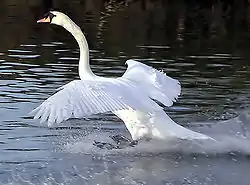
- Schulgen starts evil deeds again
Schulgen found out that there was no longer the Living Spring (water) and decided to start harming people again. In the underworld, he began to collect divas and kites under his own authority. People enjoyed a happy life for a short time, people began to disappear again. Shulgen went against the people again. Ural- Batyr decided to punish Shulgen and destroy all the divas. He drank a lake in which divas hid. Together with water, he drank all the snakes and divas that began to gnaw at his heart and liver. Ural spat out that lake, itself fell without strength. Divas were destroyed by the sons of Ural, but forces left the Hero. Ural-Batyr feels its end is approaching. He bequeaths to his descendants not to take evil in fellow travelers, always take advice from elders, from wise people, give advice to younger ones and help them.
(Olono olo itep, Kenesh alyp yorogoz. Kesene kese itep, kenesh birep yorogoz).
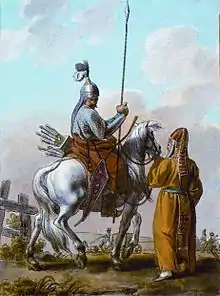
Do not shun Good, do not give in to Evil! So said Ural- Batyr and died. At that moment, a star fell from the sky and Homay learned that her husband was not alive. She flew in the image of a swan to say goodbye to her beloved. Homay decided not to take off her bird outfit anymore; she promised to lay an egg every year, which would become a white bird.
Final part
- How swans appeared in the Urals
Many years later, Homay flew to the grave of Ural. Her chicks flew with her. People did not touch them. Russian researcher R. T. Ignatiev wrote that the Bashkirs believed: "to kill a Swan is a sin, and to kill a Winch is to cry your all life."
Came to live in the Urals and the bull of Katil with his herd, submitted to man. Akbuzat led herds of horses. And a glow appeared on the grave of Ural- Batyr - the hero’s ashes turned into gold. Since then, gold appeared in the Urals.
- How rivers appeared in the Urals
In the Urals, people, animals and birds became very numerous. Remembering the prohibition of Ural- Batyr, they did not drink water from the lakes. And there weren’t enough spring water for everyone. Idel wanted to find Schulgen and kill him. But Homay convinced him to find another way to help people. Idel hit the mountain with a magic sword and a spring was born (from Mount Iremel). I ran a stream to the Yamantau mountain, which was cut by Idel into two parts. The gorge formed then began to be called Kyrykty. And the river that Idel obtained is called the people the river of Idel (Agidel). Yaik, Nugush and Hakmar set off to look for new rivers. People settled on the banks of four rivers, called them the names of the batyrs. And their names remained unforgettable.
The hero died, but with him, divas, snakes and monsters died. A good deed committed by Ural- Batyr is immortal.
English translation
The first full translation of Ural-batyr into the English language was made in 1999 by Sagit Shafikov, Professor of the Foreign Languages Department at Bashkir State University, Ufa, Russia. It appeared in the local journal called Vestnik Akademii Nauk ("Herald of Science Academy") and was followed by an improved version which appeared in 2001 in the Watandash ("Compatriot"). The final version was published alongside the original Bashkir text and the Russian translation in a glossy gift book Ural-batyr in 2003. In 2013 a new English language translation and retelling were done by David and Anastasia Andresen and published in the United States under the title "Ural the Brave." [7]
References
- Round table of the magazine "Belsky open spaces" : the reality of the myth. To the 100th anniversary of the opening of the epic " Ural-Batyr» (in Russian)
- Вахитов Р. (2013). "Цивилизация Быка на Урале". Compatriot (10). ISSN 1683-3554.
- Türk Söylence Sözlüğü (Turkish Mythological Dictionary), Deniz Karakurt, (OTRS: CC BY-SA 3.0)
- Kafkas Nart Destanlarında At Motifi, Ufuk Tavkul(in Turkish)
- "The Seven Wonders of Bashkortostan became known". Bashinform News Agency. 2009-10-08. Retrieved 2014-12-11.
- "The Bashkir epic "Ural-Batyr" should be included in the UNESCO List of "Masterpieces of the oral and intangible heritage of mankind"". Bashinform News Agency. 2010-11-30. Retrieved 2014-12-11.
- http://www.folktaleworld.com/
External literature
- Das baschkirische Volksepos in der Ubersetzung von Alia Taissina mit Illustrationen von Rais Khalilov. Taschenbuch: 108 Seiten, Auflage: 1 , Sprache: Deutsch, ISBN 3-939165-02-6, ISBN 978-3-939165-02-6
- Урал батыр. Башҡорт халыҡ ҡобайыры=Урал-батыр. Башкирский народный эпос=Ural‑batur. Bashkort Folk Epic. Ufa, 2005.
- Ergun M., Ibrahimov G. 1996: Baskurt Halk Destani Ural Batur. Ankara.
- Taissina А. 2006: «Ural-Batir. Das baschkirsche Volksepos». Germany.
External links
- Epos Ural-Batyr in Bashkir encyclopedia (in Russian)
- Ural-Batyr characters in Bashkir encyclopedia (in Russian)
- Reviews of the book “Ural-Batyr. Bashkir folk epos (in Russian)
- BASHKIR EPOS "URAL-BATYR" IN THE LIGHT OF THE TRANSLATION THEORY AND PRACTICE (in Russian)
- G. V. Yuldybaeva. MYTHOLOGICAL EPIC “URAL-BATYR” (HISTORY OF THE RESEARCH AND POPULARIZATION) “URAL-BATYR” (HISTORY OF THE RESEARCH AND POPULARIZATION)G. V. YuldybaevaThe article is devoted to the research and popularization of the Bashkir folk epic “Ural-batyr.” Bashkir folk epic is of great interest and is the top of the mythopoetic creation of the Bashkir people, the outstanding work of the world epic, as well as a valuable source for comparative study of the mythology of the peoples of the world.Key words: kubair, epic, folklore, mythology, research
External links
- «Ural-batir» (original) in the Latin alphabet (in Bashkir)
- «Ural-batir» (original) in the Latin alphabet (in Bashkir)
- «Ural-batir» in Cyrillic (in Bashkir)
- «Ural-batir» academic version
- «Ural-batir» poetic version
- «Ural-batir» prose version. Plot of the epic (Russian)
- «Ural-batir» english version. Ural-batyr (English)
- «Ural-batir» folklore version (in Bashkir)
- «Ural-batir» folklore version from M.B.Tuzbekov
- Ural-batyr in the Congress Library, US
- 'Ural the Brave (2013 English translation)
.png.webp)
.png.webp)
.png.webp)
.png.webp)
.svg.png.webp)
